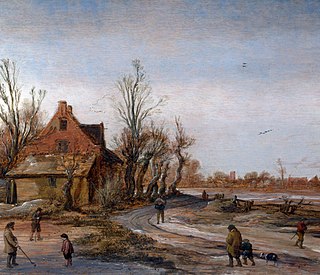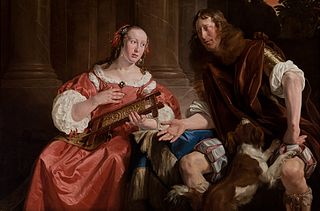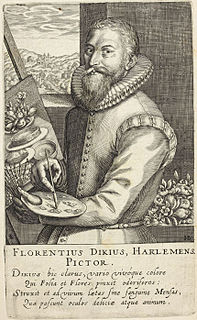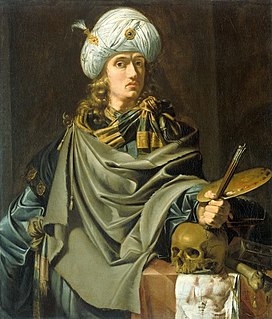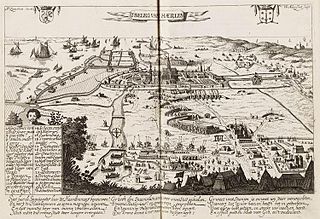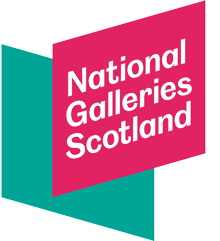
Pieter Verdonck (c.1580 – after 1636), was a man in Haarlem best known today for his portrait that was painted by Frans Hals in 1636.

Haarlem is a city and municipality in the Netherlands. It is the capital of the province of North Holland and is situated at the northern edge of the Randstad, one of the most populated metropolitan areas in Europe. Haarlem had a population of 159,556 in 2017. It is a 15-minute train ride from Amsterdam, and many residents commute to the country's capital for work.

Frans Hals the Elder was a Dutch Golden Age painter, normally of portraits, who lived and worked in Haarlem. He is notable for his loose painterly brushwork, and he helped introduce this lively style of painting into Dutch art. Hals played an important role in the evolution of 17th-century group portraiture.
Very little is known of him, though a Pieter Verdonck was recorded in the Reformed Church of Haarlem as coming from Ghent when he was engaged to be married in 1597 to Catharina Gelaynis of Vlissingen. [1] He was probably a friend of Hals, who painted him in the guise of Samson holding the jawbone. Perhaps his friend was not amused, because the painting was later painted over to reflect a man holding a wine glass and his wild hair was covered by a velvet beret. [1]

Ghent is a city and a municipality in the Flemish Region of Belgium. It is the capital and largest city of the East Flanders province, and the second largest municipality in Belgium, after Antwerp. The city originally started as a settlement at the confluence of the Rivers Scheldt and Leie and in the Late Middle Ages became one of the largest and richest cities of northern Europe, with some 50,000 people in 1300. It is a port and university city.

Vlissingen is a municipality and a city in the southwestern Netherlands on the former island of Walcheren. With its strategic location between the Scheldt river and the North Sea, Vlissingen has been an important harbour for centuries. It was granted city rights in 1315. In the 17th century Vlissingen was a main harbour for ships of the Dutch East India Company (VOC). It is also known as the birthplace of Admiral Michiel de Ruyter.
According to the RKD the jawbone is from a cow. [2] The jawbone was meant however to symbolize the jawbone of the ass that was used by Samson to slay 1,000 Philistines. The portrait has been identified "Verdonck" because of the engraving made by Jan van de Velde with a short poem describing the subject, which loosely translated, meant "This is Verdonck, the bold guest whose jawbone attacks everyone/ By not distinguishing between high or low born, he landed in the work house". The poem could be seen as moralistic warning to rederijkers whose satiric discourses went too far. Both Hals and his contemporary Salomon de Bray were rederijkers in Haarlem. De Bray made a pair of pendant pieces in a similar genre depicting David with his sword and Samson with his jawbone. De Bray's version shows Samson a moment later in the story, when he prayed to God out of thirst and was rewarded with the "fountain of the crier". [3] Hals' portrait shows the moment where Samson in triumph proclaims that "with the jawbone of an ass, he slayed 1,000 Philistines".

Samson was the last of the judges of the ancient Israelites mentioned in the Book of Judges in the Hebrew Bible and one of the last of the leaders who "judged" Israel before the institution of the monarchy. He is sometimes considered to be an Israelite version of the popular Near Eastern folk hero also embodied by the Sumerian Enkidu and the Greek Heracles.

Jan van de Velde the younger was a Dutch Golden Age painter and engraver of animal, landscape and still-life subjects. He was the son of Jan van de Velde the Elder and the father of the still life painter Jan Jansz van de Velde.
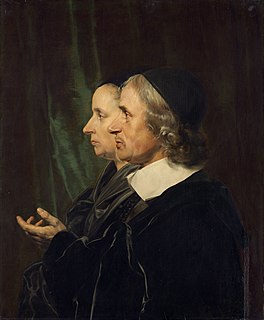
Salomon de Bray was a Dutch Golden Age architect and painter.
The fact that Hals painted his subject in close up, cutting off the knuckles of his fist, leads one to conclude the painting was meant more as a tronie than as a portrait.
A tronie is a common type, or group of types, of works common in Dutch Golden Age painting and Flemish Baroque painting that shows an exaggerated facial expression or a stock character in costume. It is related to the French word “tronche” which is slang for “mug” or head.
- Engraving by Jan van de Velde with poem
- Old photo before restoration in 1928.
- Engraving of Samson raising the jawbone, part 2 of Heroes of the Old Testament: Jahel, Samson, David, Judith by Jacob Matham
- Samson holding the jawbone while it spouts water, by Salomon de Bray

Jacob Matham, of Haarlem, was a famous engraver and pen-draftsman.
| Wikimedia Commons has media related to Pieter Verdonck . |





